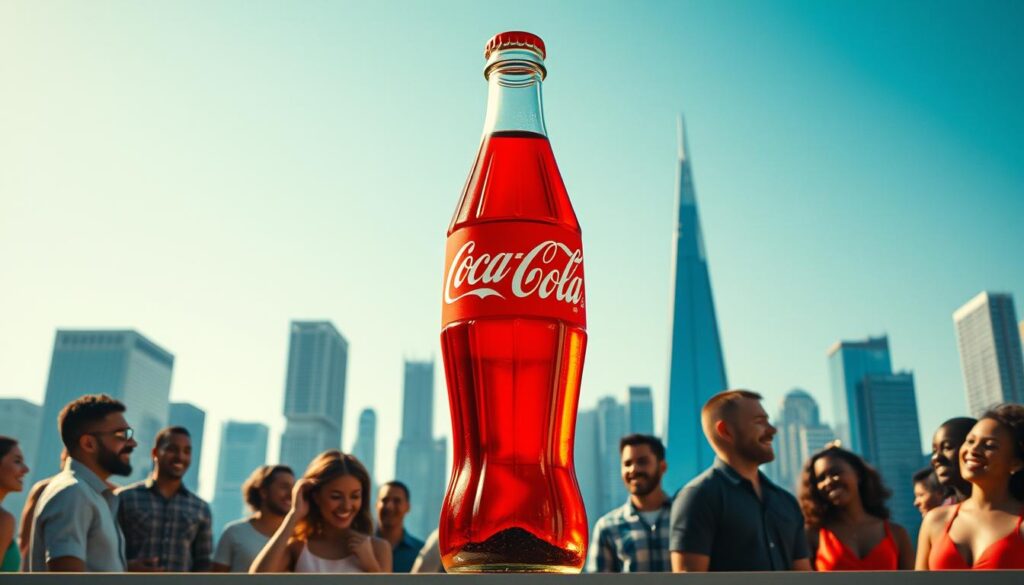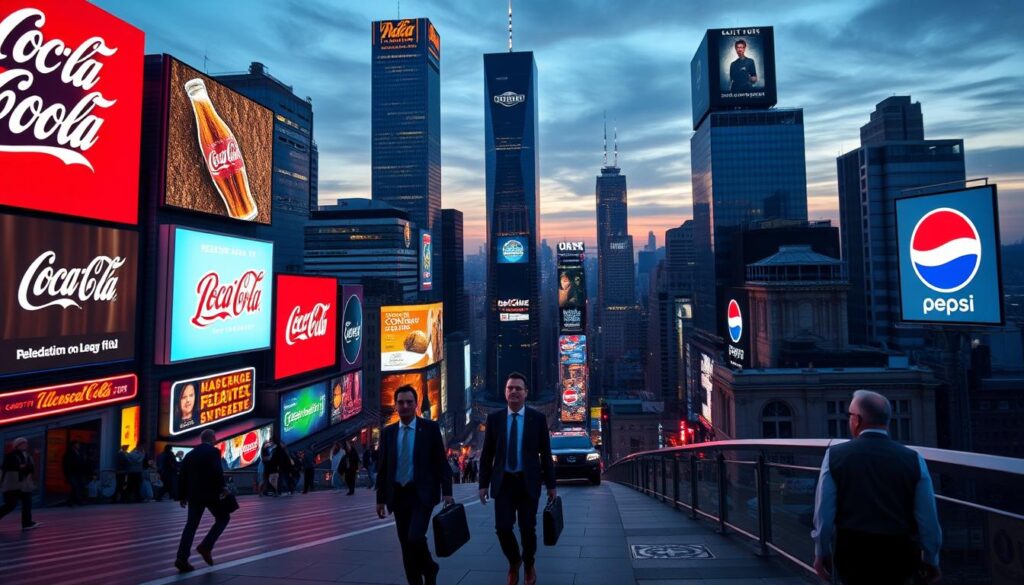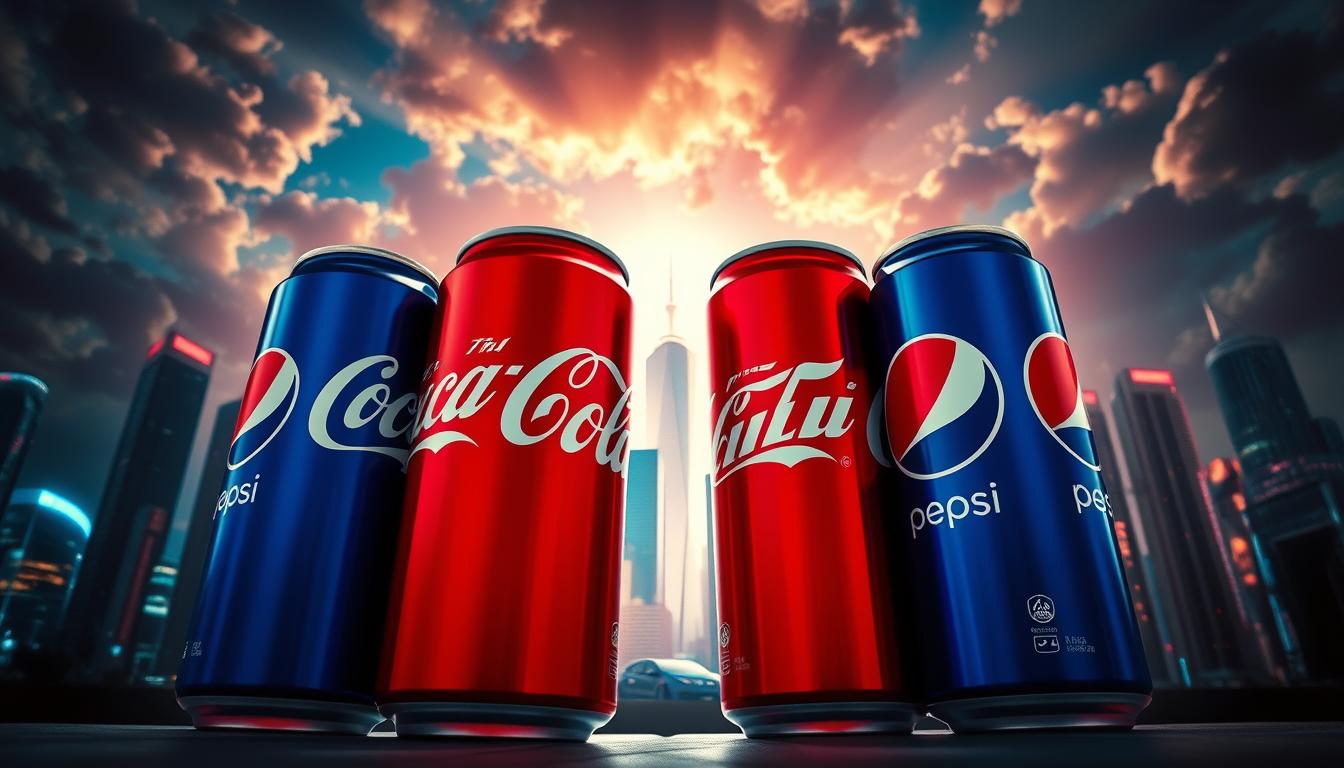The competition between Coca-Cola and Pepsi is a legendary one, with both brands vying for market share and customer loyalty. In 2022, Coca-Cola had $43 billion in net revenue, while PepsiCo generated about $86.39 billion in annual sales. This intense competition highlights the importance of business growth strategies and investment opportunities in the beverage industry. As the two brands continue to expand their product portfolios and explore new markets, startup funding and stock market insights become crucial factors in their success.
With Coca-Cola reporting over 2.2 billion servings of its beverages consumed every day, it’s clear that the brand has a strong presence in the market. However, PepsiCo’s diversified product portfolio, which consists of 23 different brands, poses a significant challenge to Coca-Cola’s dominance. As the two brands navigate the complex landscape of the beverage industry, they must consider factors such as consumer preferences, pricing strategies, and distribution channels to stay ahead of the competition. This is where business growth strategies, investment opportunities, and stock market insights come into play, enabling the brands to make informed decisions and drive growth.
Key Takeaways
- Coca-Cola and Pepsi are two of the largest beverage companies in the world, with a combined annual revenue of over $129 billion.
- Business growth strategies, investment opportunities, and startup funding are crucial factors in the success of these brands.
- Coca-Cola has a strong presence in the market, with over 2.2 billion servings of its beverages consumed every day.
- PepsiCo’s diversified product portfolio poses a significant challenge to Coca-Cola’s dominance.
- Stock market insights and business growth strategies are essential for the brands to stay ahead of the competition.
- The beverage industry is highly competitive, with brands constantly exploring new markets and product lines to drive growth.
- Investment opportunities and startup funding can help new entrants in the market to challenge the dominance of established brands like Coca-Cola and Pepsi.
The Cola Wars: A Historical Perspective
The Cola Wars between Coca-Cola and Pepsi have been ongoing for over a century. To understand the historical context of this rivalry, it’s essential to examine the birth of the two brands and their early marketing battles. Coca-Cola was first sold in 1886, while Pepsi was created in 1893. This early start gave Coca-Cola a significant advantage in terms of brand recognition and market share.
As the beverage industry evolved, both companies had to adapt to changing consumer preferences and technological advancements. The use of AI and machine learning has become increasingly important in the industry, allowing companies to analyze consumer behavior and personalize their marketing efforts. Additionally, cloud computing solutions have enabled companies to streamline their operations and improve efficiency. By incorporating personal finance tips into their marketing strategies, companies can also appeal to consumers who are looking for ways to save money and make smart financial decisions.
Here are some key statistics that highlight the historical context of the Cola Wars:
- Coca-Cola derives over 70% of its volume and 80% of its operating income from sales outside the United States.
- PepsiCo reported a revenue of $43.2 billion in 2008.
- The cola industry is highly concentrated, with four firms accounting for 89% of the production of non-alcoholic beverages.
The historical analysis of the Cola Wars includes multiple points of corporate social responsibility (CSR) used by both companies in the competition for consumer loyalty. By examining the early history of the two brands and their marketing strategies, we can gain a deeper understanding of the factors that have contributed to their success and the ongoing rivalry between them.
| Company | Year Founded | Revenue (2008) |
|---|---|---|
| Coca-Cola | 1886 | $43.8 billion |
| PepsiCo | 1893 | $43.2 billion |
Coca-Cola’s Brand Positioning Strategy
Coca-Cola’s brand positioning strategy has been highly effective in creating a strong brand identity associated with happiness and togetherness. The company has successfully leveraged web development trends to enhance its online presence and engage with customers. By prioritizing cybersecurity best practices, Coca-Cola has ensured the security and integrity of its digital platforms, protecting customer data and maintaining trust.
In addition to its digital efforts, Coca-Cola has also explored SaaS marketing strategies to reach new audiences and expand its customer base. The company’s ability to adapt to changing market trends and consumer preferences has been crucial to its success. With a strong brand identity and a solid online presence, Coca-Cola has established itself as a leader in the beverage industry.

- Approximately 200 master brands in its portfolio
- Over 700,000 people involved in delivering brands to customers and consumers daily
- Digital media spend increased from less than 30% in 2019 to approximately 60% in 2023
| Year | Digital Media Spend |
|---|---|
| 2019 | Less than 30% |
| 2023 | Approximately 60% |
Pepsi’s Counter-Positioning Approach
Pepsi has successfully implemented a counter-positioning approach to appeal to a younger demographic, focusing on fitness and nutrition as a key aspect of their marketing strategy. This approach has enabled the brand to differentiate itself from its competitors and establish a strong presence in the market.
The company’s investment in mental health awareness and weight loss programs has also contributed to its success, resonating with the younger generation’s values and priorities. By incorporating these elements into their marketing campaigns, Pepsi has been able to create a strong emotional connection with its target audience.
Some of the key elements of Pepsi’s counter-positioning approach include:
- The Pepsi Challenge campaign, which encouraged consumers to try Pepsi and experience the difference for themselves
- Youth-centric marketing, which focuses on creating engaging and relatable content for younger audiences
- Celebrity endorsements and partnerships, which help to increase brand visibility and appeal to a wider audience
By leveraging these strategies, Pepsi has been able to establish itself as a leader in the beverage industry, with a strong brand presence and a loyal customer base. The company’s commitment to fitness and nutrition, mental health awareness, and weight loss programs has also helped to drive sales growth and increase customer engagement.
Market Share Analysis and Business Growth Strategies
Coca-Cola and Pepsi have been competing in the beverage market for decades, with each company employing various strategies to gain market share. In recent years, Pepsi has been gaining ground, but Coca-Cola still holds a larger market share. The global soft drink industry has reached a market size of $400 billion, with projections to grow at a compound annual growth rate (CAGR) of 5.2% through 2028.
Both companies have been investing in digital marketing strategies to reach their target audiences. Coca-Cola’s revenue growth strategy has focused on e-commerce, which saw a 70% increase in sales during 2020. PepsiCo, on the other hand, has invested $5 billion in its “Better For You” product lines, targeting health-conscious consumers who prioritize holistic medicine and home workout routines.
The market share of each company is a critical component of their success. As of 2021, Coca-Cola held a 43.7% market share in the U.S. beverage market, while PepsiCo had a 24.1% share. The following table summarizes the market share and revenue of each company:
| Company | Market Share (2021) | Revenue (2021) |
|---|---|---|
| Coca-Cola | 43.7% | $39.0 billion |
| PepsiCo | 24.1% | $79.5 billion |

Digital Transformation in the Cola Industry
The cola industry has undergone significant digital transformation in recent years, with companies like Coca-Cola and Pepsi investing heavily in digital marketing and e-commerce platforms. This shift has been driven by the need to adapt to changing consumer behaviors and preferences. SEO best practices have become essential for these companies to stay competitive online.
One key aspect of digital transformation in the cola industry is social media marketing. Companies are using social media platforms to engage with customers, promote their products, and build brand awareness. For example, Coca-Cola has used social media to launch successful campaigns like “Share a Coke” and “Taste the Feeling”.
In addition to social media marketing, companies in the cola industry are also exploring dropshipping business models. This involves partnering with third-party suppliers to ship products directly to customers, reducing the need for inventory storage and management. This approach can help companies to reduce costs and improve efficiency.
Some key statistics highlighting the digital transformation in the cola industry include:
- Coca-Cola’s digital academy trained over 500 people in digital skills in its first year.
- Graduates of the academy have implemented over 20 digital, automation, and analytics approaches at over 10 sites.
- Digital-skills training is being rolled out to around 4,000 employees across Coca-Cola’s organization.
Overall, the digital transformation in the cola industry is driving innovation and growth, and companies that adapt to these changes are likely to stay ahead of the competition.
| Company | Digital Transformation Initiatives |
|---|---|
| Coca-Cola | Digital academy, social media marketing, dropshipping business |
| Pepsi | Social media marketing, e-commerce platforms, digital advertising |
Investment Opportunities in the Beverage Sector
The beverage sector has seen significant investment opportunities in recent years, with the rise of craft beverages and e-commerce platforms. To stay ahead, companies are utilizing email marketing tips to reach their target audience and investing in online learning platforms to enhance their marketing strategies. Additionally, career development tips are being used to attract and retain top talent in the industry.
Some key statistics highlight the growth of the beverage sector. The food and beverage e-commerce revenue is projected to surpass $47 billion by 2025, with approximately 150 million people forming the online food and beverage consumer base. Furthermore, nearly half of consumers utilize social media to search for places to eat and drink, making it essential for companies to have a strong online presence.

Investors are taking notice of the beverage sector’s growth potential, with 149 private equity deals in the food and beverage sector in Q3 of 2024, marking the highest level since 2017. The Section 48 investment tax credit under the Inflation Reduction Act (IRA) also provides a significant incentive for manufacturers, with a base credit of 6% that can increase to up to 30% with compliance to prevailing wage and apprenticeship standards.
As the beverage sector continues to evolve, companies must stay ahead of the curve by investing in new products, technologies, and marketing strategies. By leveraging email marketing tips, online learning platforms, and career development tips, companies can attract and retain customers, drive growth, and stay competitive in the market.
Innovation and Product Diversification
Coca-Cola and Pepsi have been innovating and diversifying their products to stay ahead in the market. This strategy has helped them to reduce their dependence on a single product and increase their revenue streams. In recent years, both companies have introduced health-conscious product lines and sustainability initiatives, which have been well-received by consumers.
With the rise of freelancing opportunities and remote job trends, companies are looking for ways to adapt to the changing workforce. This shift has also led to an increase in demand for resume writing services as professionals look to update their skills and experience. In the beverage industry, this trend has resulted in companies looking for innovative ways to reach their target audience.
Health-Conscious Product Lines
Coca-Cola has introduced several health-conscious products, including low-sugar and zero-calorie versions of their popular drinks. Pepsi has also followed suit, launching a range of healthy beverages and snacks. These products have been well-received by consumers who are looking for healthier options.
Sustainability Initiatives
Both Coca-Cola and Pepsi have implemented sustainability initiatives to reduce their environmental impact. These initiatives include reducing waste, conserving water, and using renewable energy sources. By adopting these sustainable practices, companies can reduce their costs and improve their brand reputation.
In conclusion, innovation and product diversification have been key strategies for Coca-Cola and Pepsi to stay ahead in the market. By introducing health-conscious products and sustainability initiatives, they have been able to reduce their dependence on a single product and increase their revenue streams. As the workforce continues to shift towards freelancing opportunities and remote job trends, companies must adapt to these changes and look for innovative ways to reach their target audience.
Consumer Behavior and Brand Loyalty
Understanding consumer behavior and brand loyalty is crucial for businesses to develop effective business growth strategies. In today’s competitive market, companies like Coca-Cola and Pepsi must adapt to changing consumer preferences and behaviors. According to recent studies, increasing retention by just 5% can boost profits by as much as 95% (Bain & Company). This highlights the importance of investing in customer loyalty programs and personalized experiences to drive startup funding and revenue growth.
Some key statistics that illustrate the significance of consumer behavior and brand loyalty include:
- 73% of customers expect better personalization as technology advances (Salesforce)
- 80% of consumers are more likely to make a purchase when brands offer personalized experiences (Epsilon)
- 79% of consumers say loyalty programs increase their likelihood of continuing business with brands (Bond Brand Loyalty)
By leveraging these insights, companies can create targeted investment opportunities that cater to their customers’ needs and preferences. For instance, offering branded merchandise or incentivizing brand advocacy through rewards can encourage customers to promote the brand to their networks. Ultimately, fostering brand loyalty requires ongoing investment and alignment with consumer values to maintain meaningful connections and drive sustainable business growth strategies.

Marketing Strategy Evolution in the Digital Age
In today’s fast-paced digital landscape, companies like Coca-Cola and Pepsi are evolving their marketing strategies to stay ahead of the curve. By leveraging digital marketing strategies, these brands can effectively reach and engage their target audiences. SEO best practices also play a crucial role in ensuring their online presence is optimized for search engines.
A key aspect of their digital marketing approach is social media marketing. By maintaining a strong presence on platforms like Facebook, Twitter, and Instagram, Coca-Cola and Pepsi can interact with customers, share brand stories, and promote their products. This not only helps build brand awareness but also fosters customer loyalty and retention.
Some notable statistics highlight the importance of digital marketing in the beverage industry. For instance, the digital ad spend in this sector increased by 20% last year, indicating a significant shift in marketing budgets towards digital channels. Additionally, companies that prioritize customer experience are 60% more profitable than their competitors, underscoring the need for effective digital marketing strategies and SEO best practices to drive business growth.
To stay competitive, businesses must adapt to the evolving marketing landscape and prioritize social media marketing and other digital channels. By doing so, they can enhance customer engagement, increase brand visibility, and ultimately drive revenue growth.
Conclusion: Lessons in Brand Warfare and Market Leadership
As the battle between Coca-Cola and Pepsi has shown, the beverage industry offers valuable lessons in brand warfare and market leadership. Successful business growth strategies, smart investment opportunities, and strategic startup funding are key to navigating the complexities of this dynamic market.
From Coca-Cola’s unwavering brand positioning to Pepsi’s innovative counter-strategies, both companies have demonstrated the importance of adaptability, industry knowledge, and customer-centric marketing. The ability to anticipate trends, identify niche opportunities, and cultivate strong industry connections are all essential elements of market leadership.
Aspiring entrepreneurs and established businesses alike can learn from the tactics employed by these beverage giants. By understanding the nuances of brand warfare, leveraging data-driven insights, and fostering a culture of innovation, companies can position themselves for long-term success in the highly competitive consumer goods sector.
FAQ
What are the key business growth strategies and investment opportunities in the beverage industry?
The beverage industry, particularly the battle between Coca-Cola and Pepsi, offers numerous business growth strategies and investment opportunities. These include exploring global market expansion, product diversification, and leveraging emerging technologies like AI and cloud computing solutions.
How has the historical rivalry between Coca-Cola and Pepsi shaped the industry?
The Cola Wars between Coca-Cola and Pepsi have been ongoing for over a century, with both brands vying for market share and customer loyalty. This rivalry has shaped the industry through their marketing strategies, brand positioning, and key historical turning points.
What are the key elements of Coca-Cola’s successful brand positioning strategy?
Coca-Cola’s brand positioning strategy has been highly effective in creating a strong brand identity, with a focus on happiness, togetherness, and iconic marketing campaigns. The company has also leveraged emerging trends in web development, cybersecurity, and SaaS marketing to strengthen its brand.
How has Pepsi’s counter-positioning approach impacted the industry?
Pepsi’s counter-positioning approach has been focused on appealing to a younger demographic, with campaigns like the Pepsi Challenge, youth-centric marketing, and celebrity endorsements. The company has also explored initiatives in fitness, nutrition, and mental health awareness to differentiate itself from Coca-Cola.
What are the key factors in the market share analysis and business growth strategies of Coca-Cola and Pepsi?
The market share analysis and business growth strategies of Coca-Cola and Pepsi are critical components of their success, including global market penetration, revenue comparison, and distribution networks. These strategies have also been influenced by emerging trends in holistic medicine, home workout routines, and digital marketing.
How has the digital transformation impacted the cola industry?
The digital transformation in the cola industry has been significant, with both Coca-Cola and Pepsi investing heavily in digital marketing, e-commerce platforms, and leveraging SEO best practices, social media marketing, and dropshipping business models.
What are the key investment opportunities in the beverage sector?
The investment opportunities in the beverage sector are numerous, with both Coca-Cola and Pepsi investing heavily in new products and technologies. This includes analyzing stock performance, market trends, and risk assessment, as well as exploring emerging trends in email marketing, online learning, and career development.
How have Coca-Cola and Pepsi’s innovation and product diversification strategies evolved?
The innovation and product diversification strategies of Coca-Cola and Pepsi have been critical components of their success, including the development of health-conscious product lines and sustainability initiatives. These strategies have also been influenced by trends in resume writing, freelancing, and remote job opportunities.
What factors contribute to the consumer behavior and brand loyalty of Coca-Cola and Pepsi?
The consumer behavior and brand loyalty of Coca-Cola and Pepsi are complex and multifaceted, influenced by a range of factors such as business growth strategies, investment opportunities, and startup funding.
How have Coca-Cola and Pepsi’s marketing strategies evolved in the digital age?
The marketing strategy evolution of Coca-Cola and Pepsi in the digital age has been significant, with both brands investing heavily in digital marketing, social media presence, content marketing, and customer engagement tactics. These strategies have been shaped by trends in SEO, social media marketing, and digital marketing best practices.
